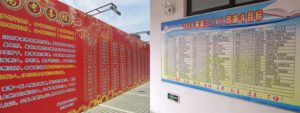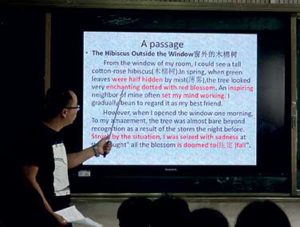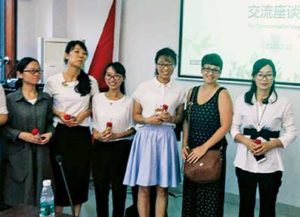Kate Ehrlich
Among the myriad professional development opportunities available to teachers, I find the most beneficial experiences have been those that allowed me to see the issues facing educators from alternative perspectives – to learn how other school systems address achievement gaps, view the roles of teachers and students and prepare young people to be productive citizens. A notable benefit of teacher travel and teacher-exchange programs is the opportunity to see firsthand how another country approaches the education of its children.

While there were some obvious differences between the Chinese and American education systems, what struck me most were the commonalities. In China, I saw school systems working to improve teacher performance, weighing the merits of different instructional strategies, and considering the impact of high-stakes testing. These same issues are a part of the daily conversations in my own school system.
Our first visit to a Chinese public school was in Shanghai. We toured Jiashan Senior High School and had a discussion with a small group of its staff members. While at the high school, we also observed an English lecture being delivered to a group of approximately 40 adolescent students, both girls and boys. The students had written English sentences for homework that incorporated advanced vocabulary and metaphor, and a selection of these sentences were being displayed on a screen in the front of the room. The teacher asked questions about the student work and called on the writers to identify their mistakes.
The classroom where the lesson was delivered was a special one used by the staff to model quality teaching. As observers, we sat at desks on a raised platform at the back of the room, while the instructor was filmed with cameras mounted to the ceiling. The film and others like it, we were told, could be used as a model of exemplary teaching for other educators. They could also provide instructors an opportunity to get feedback on their performance from master teachers and supervisors. I was impressed with the school system’s commitment to ensuring that students received high quality instruction and the rigor of their teacher evaluation system. In my own school, we use an evaluation system that requires an administrator to evaluate teacher performance but does not include a mechanism to allow teachers to formally review the work of other teachers. All school systems debate the most effective way to evaluate their staff, and I was intrigued by the possibilities of a system, like the one I was seeing in China, that provided alternate opportunities for growth and reflection.

While in Beijing, we met with teachers and administrators from private schools that educate students on evenings, weekends, and school holidays. The focus of these programs was to give students a competitive edge in testing, improve their understanding of content, and provide opportunities for enrichment. These schools tended to embrace teaching methods reminiscent of those promoted in American schools. I saw films of teachers using manipulatives to teach students mathematics. Teachers used images and songs to help students learn vocabulary. These students were actively participating in their learning. They were dialoguing with their teachers and engaging directly with the material. These private schools offered student-directed opportunities for learning that were absent from traditional Chinese classrooms. All methods have their advantages and disadvantages, and it was thought-provoking to see how different schools within the same country were addressing these concerns.
At home, we also grapple with questions about which teaching techniques are best for boosting student achievement. Blended learning is a style that combines online and traditional teaching techniques. My district has initiated a program, now in its second year, to help a group of educators pilot this new approach with the hope that they will become mentors for other willing instructors. In my own classroom, I must balance the demands of time with my goal of engaging students and ensuring they deeply understand the content. Seeing the struggles of teachers in China contemplating the advantages of traditional and more modern approaches reminded me of my own personal struggles.
During my visit to China, I did not initially realize how much emphasis was placed on test scores, until standing outside the Jiashan Senior High School at the end of my visit, I inquired about a large red poster stretching the length of the sidewalk covered with text. Much to my surprise, I was told this display included the names and test scores of all the students at the school. While visiting a school for minority students in Guizhou province, I saw similar posters (this time with student photographs) displaying student names, scores, and class rank within the school building. At first taken aback by the public display of each student’s academic information, I quickly came to terms with the fact that my own students face similar (albeit, perhaps, less obvious) pressures. I often see my students comparing class rank and feeling extreme anxiety if they earn anything less than an A in their courses. My students will avoid elective courses, that might spark a genuine interest and lead to a future career path, because these unweighted courses might reduce their grade point average. While student grades could never be displayed so publicly in an American public school, it doesn’t mean the same pressures and concerns are not a part of my students’ daily lives.

In China, like in the US, a great deal of money, time, and energy is spent trying to help students succeed in exams. I was told that subjects other than English, math, and Chinese were often sacrificed in order to boost student performance in the core areas. As a history and social studies teacher, I have seen instructional time for my content areas reduced or eliminated for younger students, so these students can focus their energy on English and math education – the two subjects that are the focus of many high-stakes exams. Students in China expressed frustration with this system, and I saw an unfortunate similarity between China’s educational system and my own.
Visiting China’s schools did not answer my own questions about how best to educate students. It did, however, help me reflect on my own teaching. I saw other educators who desired to educate their students to the best of their abilities and who were questioning the best methods to do so. Teachers face similar struggles around the globe, but seeing how others address the demands of our profession allowed me to better reflect on what we do well and on what we can improve.
The author has been teaching social studies and history for 13 years in Frederick County, Maryland. She earned a master’s degree in the Humanities from Hood College in 2010 and her National Board Certification in 2011. She can be reached at kate.ehrlich@fcps.org.
